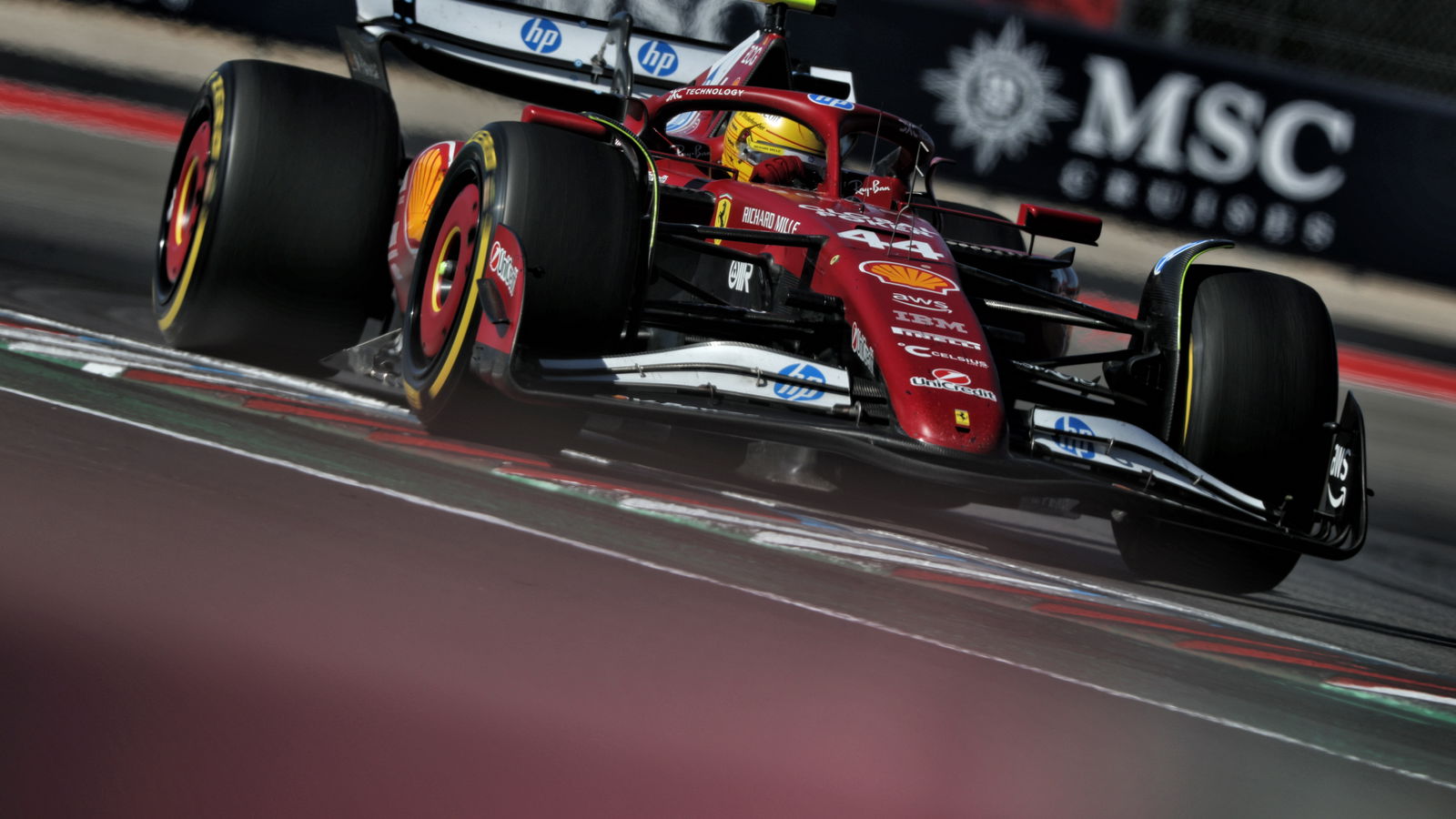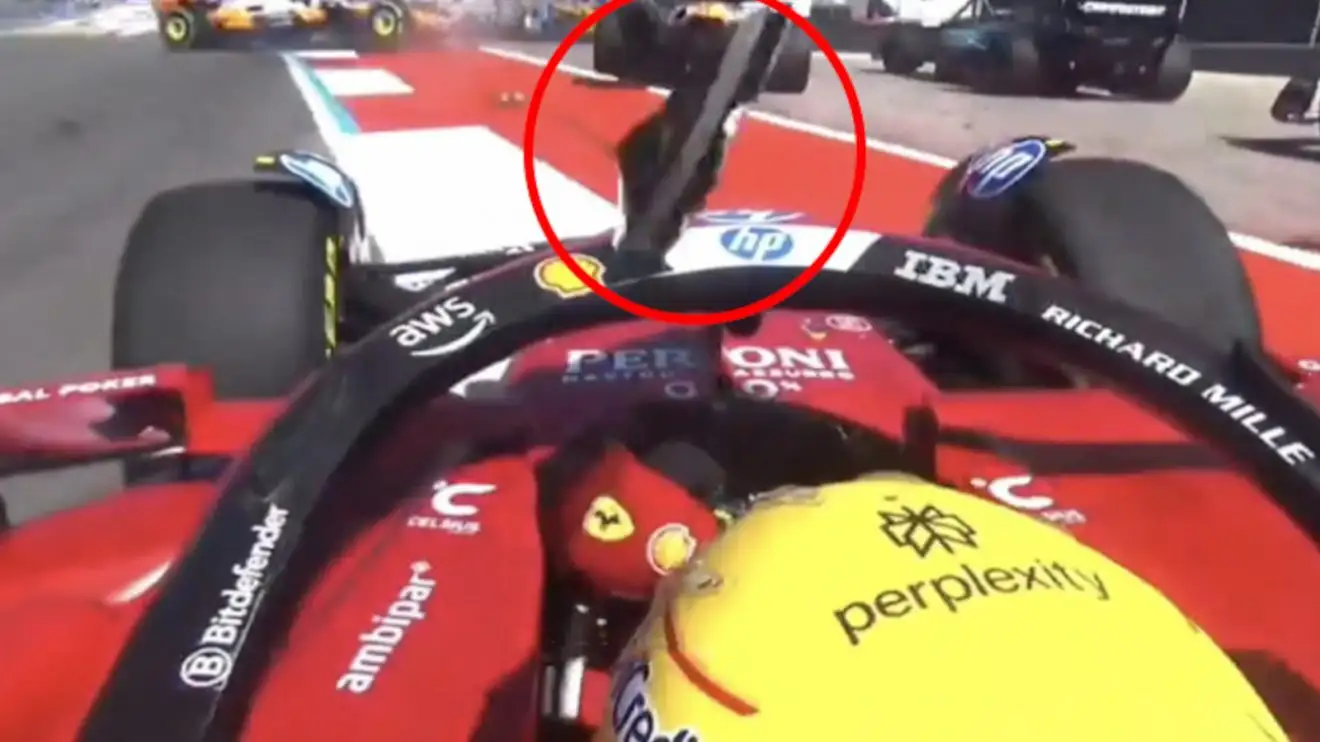Eight seconds. That’s all it took. On a chaotic Saturday Sprint in Austin, Texas, with cars roaring into Turn 1 at 150 miles per hour, the world of Formula 1 held its collective breath. Debris exploded from a crash ahead, and for one terrifying moment, a piece of sharp, jagged carbon fiber—traveling faster than a bullet train—was on a precise, deadly trajectory. Its target: the helmet of Lewis Hamilton, one of the greatest drivers in the sport’s history.
Inches. Millimeters. That was the margin. The only thing standing between the seven-time world champion and a catastrophic, career-ending—or life-ending—injury was a single, three-pronged titanium bar. A device that, when it was first introduced, was almost universally despised by the very drivers it was designed to protect.
This is the story of the Halo, Formula 1’s silent guardian. And for Lewis Hamilton, this wasn’t even the first time it had saved his life.

The onboard camera from Hamilton’s car captured the heart-stopping moment in Austin. As he navigated the turn, debris from the cars ahead erupted in all directions. One lethal piece launched straight at his cockpit. Then, a jarring impact. The sound of metal meeting carbon fiber at an impossible speed. When analyzed, the footage makes your blood run cold. Hamilton’s head was leaned into the corner, and the debris was aimed directly at his visor. The Halo, however, did its job perfectly. The titanium structure absorbed the full force of the strike and deflected the wreckage over his head.
It wasn’t luck. It was engineering preventing a tragedy in real-time. But to understand just how fortunate Hamilton was, and how thin the line is between glory and disaster in modern F1, we have to rewind to 2021.
The setting was Monza, the Italian Grand Prix. Hamilton and his arch-rival, Max Verstappen, were locked in one of the most brutal and intense championship battles the sport had ever seen. Fighting wheel-to-wheel into Turn 2, they made contact. In an instant, Verstappen’s Red Bull was launched into the air, its wheels spinning menacingly. The car traveled over Hamilton’s Mercedes and came to rest directly on top of his cockpit.
The images from that day are chilling. Verstappen’s right-rear wheel—weighing over 20 pounds and attached to the full weight of the car—crashed down and struck Hamilton’s helmet. Without the Halo, the full, crushing weight of the Red Bull would have compressed directly onto Hamilton’s head and neck. The outcome would have been unthinkable.
“Thank God for the halo,” Hamilton said in the aftermath, his voice shaken but firm. “That ultimately, I think, saved me. And saved my neck.” He later reflected on the incident with a gravity that cut through the noise of the sport. “I don’t think I’ve ever been hit on the head by a car before, and it’s quite a shock for me… My head really is quite far forward… I’m so, so grateful that I’m still here.”

“Still here.” Two words that underscore the life-and-death stakes of their profession. But the Halo, the device Hamilton was so grateful for, wasn’t some simple upgrade. It was an innovation born from unimaginable tragedy.
Formula 1 introduced the Halo in 2018, but its development was a direct response to a series of devastating incidents that forced the sport to confront its most uncomfortable truth. In 2009, Formula 2 driver Henry Surtees was killed at Brands Hatch when a wheel from another car struck his helmet. In 2015, IndyCar driver Justin Wilson died at Pocono after being struck by debris. And most notably, in 2014, Formula 1 driver Jules Bianchi crashed at Suzuka, suffering severe head trauma that he would succumb to months later.
Each incident involved the one thing drivers, clad in their carbon-fiber survival cells, couldn’t protect themselves from: external impacts to the head.
The FIA, F1’s governing body, investigated multiple cockpit protection options before settling on the Halo. The titanium structure was chosen for its incredible strength-to-weight ratio, able to withstand massive forces—like the weight of an entire F1 car, as proven at Monza—while adding minimal weight.
But its introduction was met with fierce resistance. Drivers and fans alike called it ugly, a betrayal of the open-cockpit DNA of Formula 1. They complained about visibility. Some, including Hamilton himself, were vocal critics, wanting it banned before it even appeared on a car.
The data, however, was undeniable. And seven years later, we have documented, terrifying proof that the Halo has, at least twice, saved Lewis Hamilton’s life. Monza proved it could withstand the crushing weight of another car. Austin proved it could deflect high-speed, lethal debris with zero warning.
What makes the Austin incident so particularly revealing is the mindset of the man at the center of it. It happened on the opening lap of a sprint race. Visibility was compromised, chaos was erupting, and reaction time was non-existent. Hamilton had no chance to dodge, no opportunity to protect himself. The Halo was his only defense, and it worked in milliseconds.

Yet, hours later, what was Hamilton focused on? His near-podium finish. “This is the closest I’ve been to a podium in god knows how long,” he reflected. And then, he added a line that perfectly encapsulates the razor-edge focus of a champion: “My goal is to win tomorrow.”
Hours after a piece of debris nearly ended his career, his singular focus was on competing, on pushing for victory, on racing. That is the mentality of a modern Formula 1 driver. The dangers haven’t vanished; they have simply been mitigated by extraordinary safety equipment.
But this raises a darker question. How many other drivers have had similar near-misses that didn’t make headlines? How many times has the Halo silently deflected a piece of gravel or a small carbon shard without anyone ever noticing? The device works in silence, its success visible only when something goes catastrophically wrong.
Formula 1 now stands at a crossroads, facing three possible futures. In one, the sport investigates debris patterns from these crashes and strengthens car construction to prevent these incidents from happening in the first place. In another, a driver isn’t as fortunate. A piece of debris finds a gap, or the impact is too great, and the sport is forced into another reckoning about whether the spectacle is worth the cost. Or, in the third and most likely scenario, nothing changes. The Halo continues its silent watch, and drivers compete knowing that a thin bar of titanium is all that separates racing from tragedy.
Has the Halo made Formula 1 too safe, or just safe enough? The question is complex, but the evidence is brutal. Lewis Hamilton is back in the cockpit, a living testament to the Halo’s success. But as he straps himself in, he knows, as all drivers do, that in modern Formula 1, the margin between competition and catastrophe is measured in the thickness of a titanium bar. And it leaves everyone with one haunting question: What happens on the day the Halo isn’t enough?